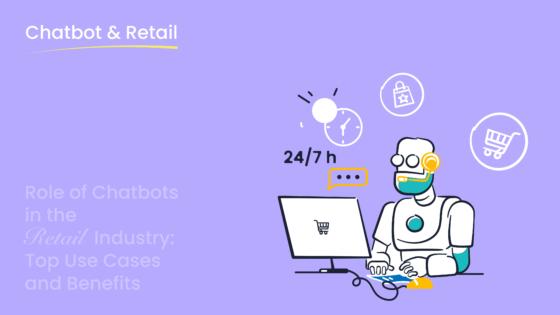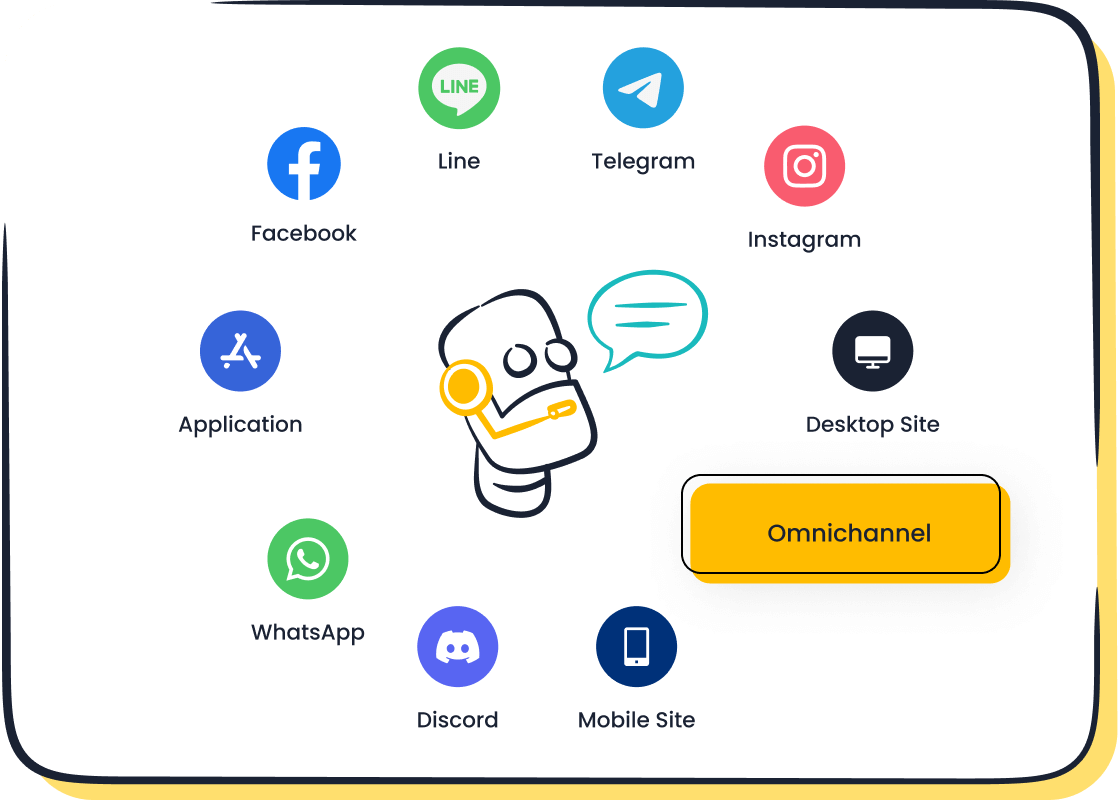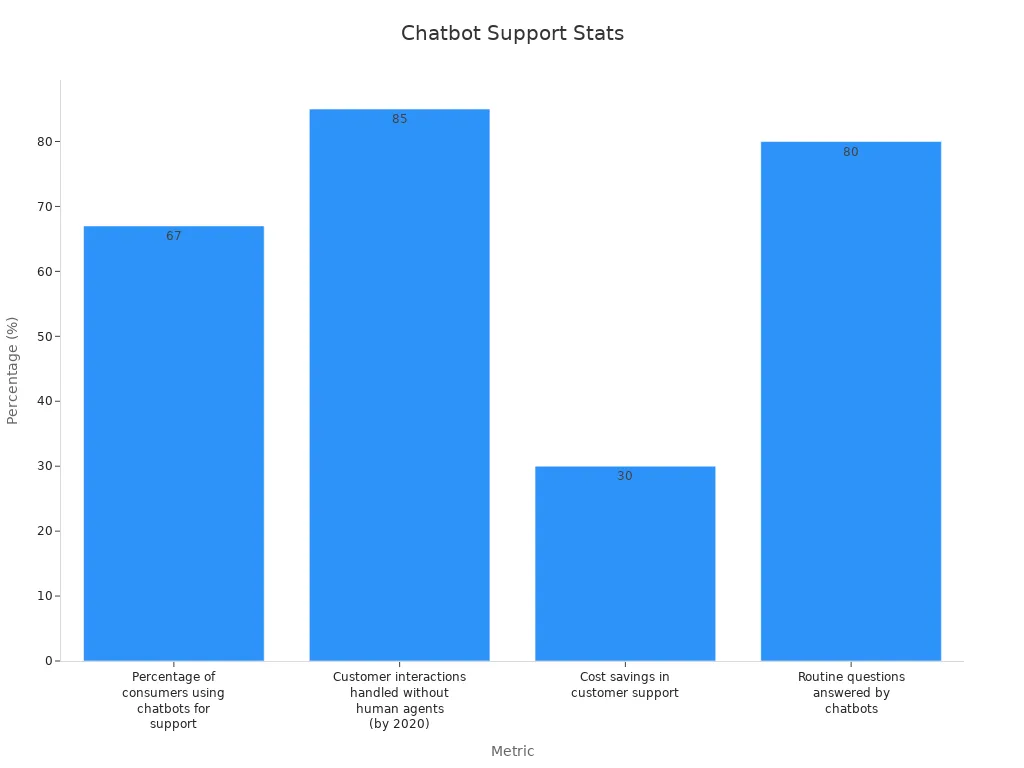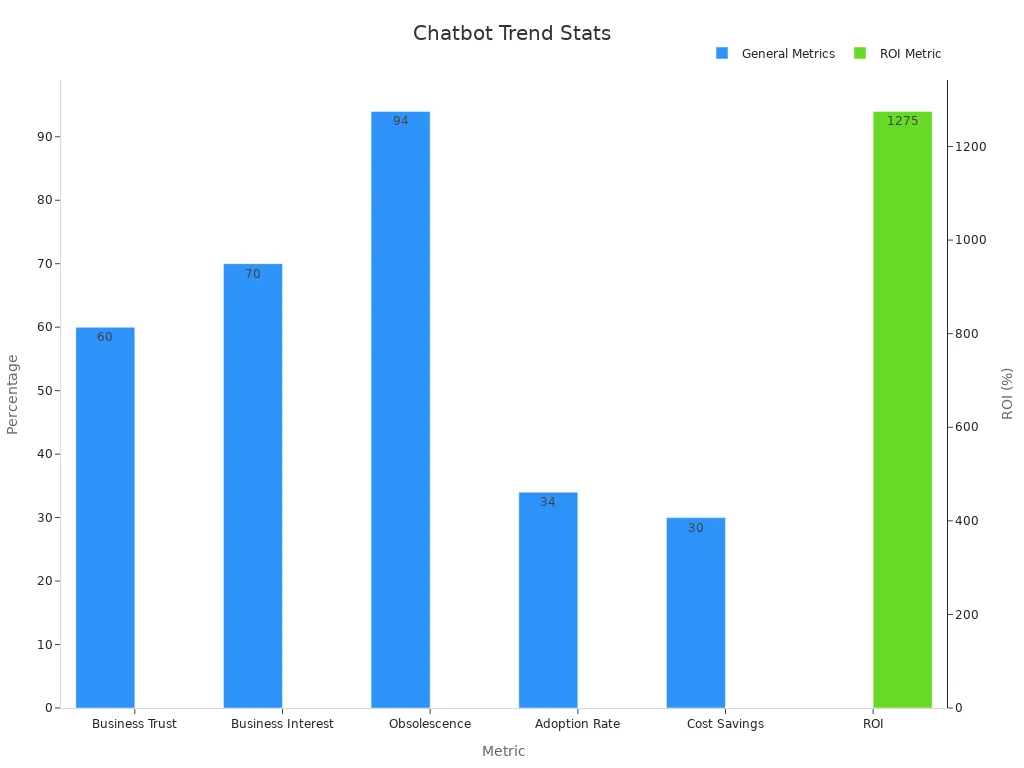Exploring Top Chatbot Platforms for Ecommerce

In today’s fast-paced ecommerce world, staying ahead means embracing tools that make life easier for both you and your customers. A chatbot for ecommerce websites has become a game-changer, helping you improve customer experience by offering quick responses, personalized recommendations, and 24/7 support. Did you know businesses using chatbots have seen sales jump by 67%? Plus, automating repetitive tasks can save up to $23 billion annually. With AI-powered chatbots like Sobot, you can reduce costs, improve engagement, and deliver top-notch customer support. These tools don’t just make operations smoother—they drive ecommerce success and increase revenue.
What Are Ecommerce Chatbot Platforms?
Definition and Overview
Ecommerce chatbot platforms are tools designed to automate conversations between you and your customers. These platforms use advanced technologies like AI and machine learning to provide instant responses, solve queries, and even guide customers through their shopping journey.
There are different types of chatbots available, each tailored to specific needs:
| Type of Chatbot | Description |
|---|---|
| AI-driven Chatbots | Utilize machine learning and natural language processing to provide personalized responses and learn from interactions. |
| Rules-based Chatbots | Operate on predefined rules and conditions, providing static responses based on user inputs. |
| Hybrid Chatbots | Combine AI capabilities with rules-based systems for a versatile conversational experience. |
| Enterprise Chatbots | Offer 24/7 support, integrating with CRM systems to personalize user interactions and improve service. |
These platforms aren’t just about answering questions—they’re about creating meaningful interactions that keep your customers coming back.
Key Functions of Ecommerce Chatbots
Ecommerce chatbots do more than chat. They act as virtual assistants, helping you manage customer inquiries, recommend products, and even close sales. Here’s what they can do:
- Customer Support: Provide instant answers to FAQs, reducing wait times and improving satisfaction.
- Personalized Recommendations: Suggest products based on browsing history or preferences, boosting sales by up to 25%.
- Order Tracking: Help customers check delivery statuses without needing to call or email.
- Lead Generation: Collect customer information and qualify leads, increasing conversion rates by 12%.
By automating these tasks, chatbots save you time and money while enhancing the shopping experience for your customers.
Why Chatbots Are Essential for Ecommerce Businesses
Imagine having a tool that works 24/7, handles thousands of inquiries, and never takes a break. That’s what ecommerce chatbots offer. They’re essential because they help you scale your business without adding extra staff.
Here’s why they’re a must-have:
- Boost Sales: Chatbots can increase sales by 67% on average, thanks to their ability to engage customers and offer tailored recommendations.
- Improve Customer Satisfaction: Businesses using chatbots have seen a 37% improvement in customer satisfaction scores.
- Reduce Costs: By automating repetitive tasks, chatbots cut customer acquisition costs by 30% and reduce cost per conversion by 70%.
- Enhance Retention: Chatbots keep customers engaged, leading to a 50% boost in retention rates.
With ecommerce expected to generate $112 billion in chatbot transactions by 2025, adopting AI-powered conversation tools is no longer optional—it’s essential for staying competitive.
Benefits of Using Chatbots in Ecommerce

Enhancing Customer Support and Engagement
Chatbots are revolutionizing customer support by offering instant responses and multichannel support. Imagine a tool that handles inquiries 24/7 without needing a break. That’s what ecommerce chatbots do. They answer routine questions, track orders, and even guide customers through their shopping journey. With 67% of consumers already using chatbots for support, you’re tapping into a proven customer engagement strategy.
These AI chatbots don’t just save time—they enhance customer interactions. By handling up to 80% of routine queries, they free up your team to focus on complex issues. Plus, they’re available round the clock, which 64% of users prefer. The result? Improved customer satisfaction and a smoother shopping experience.
| Statistic | Value |
|---|---|
| Percentage of consumers using chatbots for support | 67% |
| Customer interactions handled without human agents (by 2020) | 85% |
| Cost savings in customer support | Up to 30% |
| Routine questions answered by chatbots | Up to 80% |

Automating Repetitive Tasks
Repetitive tasks can drain your team’s energy and time. Chatbots step in to automate these processes, allowing you to focus on growing your business. From scheduling social media posts to sending email reminders, task automation simplifies operations. Research shows that 45% of employee time could be automated, and chatbots are leading the charge.
Ecommerce chatbots also reduce cart abandonment by sending automated reminders. They resolve 90% of customer queries in under 11 messages, ensuring quick and efficient service. By automating these tasks, you not only save time but also boost productivity across departments.
- Eliminate repetitive tasks to free up time for critical processes.
- Automate reminders to reduce cart abandonment.
- Use AI-powered chatbots to upsell and cross-sell products.
Boosting Sales Through Personalized Recommendations
Personalized recommendations are a game-changer for ecommerce success. Chatbots analyze browsing habits and purchase history to suggest products tailored to each customer. This approach doesn’t just enhance customer engagement—it boosts sales. Studies show that average order value (AOV) increases by 5% to 35% when chatbots offer personalized suggestions.
These ecommerce chatbots act like virtual shopping assistants, guiding customers to products they’ll love. By using AI-driven algorithms, they create a shopping experience that feels personal and intuitive. This strategy not only increases conversions but also builds customer loyalty.
| Statistic | Impact |
|---|---|
| AOV increase due to personalized recommendations | 5%-35% |
| Chatbots analyze customer data for tailored suggestions | Enhanced shopping experience |
Reducing Operational Costs
Running an ecommerce business can get expensive, especially when it comes to customer support. Hiring and training agents, maintaining systems, and handling high volumes of inquiries all add up. That’s where chatbots step in to save the day—and your budget. By automating repetitive tasks and streamlining customer interactions, chatbots help you cut costs without sacrificing quality.
One of the biggest advantages of using a chatbot is its ability to handle routine questions 24/7. Instead of paying for additional staff to manage peak hours, you can rely on a chatbot to do the heavy lifting. This reduces your operational costs by up to 30%. Imagine saving thousands of dollars annually while still delivering excellent service. In fact, businesses using chatbots report average yearly savings of $300,000. That’s a game-changer for companies of all sizes.
Here’s a quick look at how chatbots impact your bottom line:
| Statistic | Impact |
|---|---|
| Cost Reduction | Up to 30% reduction in operational costs due to automation of customer service |
| Annual Savings | Average savings of $300,000 per year for businesses using chatbots |
| Global Savings | Estimated savings of over $11 billion globally by 2025 due to chatbot implementation |
But it’s not just about cutting costs. Chatbots also help you increase sales by up to 67%, thanks to their ability to engage customers and offer personalized recommendations. This dual benefit—saving money and boosting revenue—makes chatbots an essential tool for ecommerce success.
By automating responses to common inquiries, chatbots free up your team to focus on more complex tasks. This improves efficiency across the board. Plus, with lower support costs, you can reinvest those savings into growing your business. Whether you’re a small startup or a large retailer, chatbots make it easier to scale without breaking the bank.
💡 Tip: Start small by automating FAQs and gradually expand your chatbot’s capabilities. You’ll see the savings add up in no time.
How Do Ecommerce Chatbot Platforms Work?
Natural Language Processing (NLP) and AI Capabilities
Ever wondered how chatbots understand what you’re asking? That’s where Natural Language Processing (NLP) comes in. It’s the magic behind AI chatbot platforms that allows them to interpret your words, detect intent, and respond intelligently. Advanced NLP techniques, like intent classification and sentiment analysis, make these tools smarter every day. They don’t just answer questions—they understand context, tone, and even emotions.
For ecommerce, this means better customer interactions. AI chatbots powered by NLP can resolve queries faster and more accurately. Research shows that these advancements lead to a 20% increase in average order value, a 15% boost in customer retention, and a 30% reduction in cart abandonment. By using NLP, chatbots create a seamless shopping experience that feels personal and intuitive.
| Metric | Result |
|---|---|
| Increase in average order value | 20% |
| Boost in customer retention | 15% |
| Reduction in cart abandonment | 30% |
Integration with Ecommerce Platforms and CRMs
A chatbot isn’t just a standalone tool—it’s part of a bigger system. The best AI chatbot platforms integrate seamlessly with your ecommerce platform and CRM. This connectivity allows you to track customer preferences, buying behaviors, and service inquiries all in one place.
Here’s how integration works for you:
- Chatbots collect customer data during interactions and sync it with your CRM for personalized recommendations.
- They route queries to the right department, improving response times.
- They unify customer interactions across platforms, ensuring consistent service.
This integration doesn’t just make your operations smoother—it helps you deliver a better experience for your customers.
Automation of Customer Interactions
Imagine having a tool that works 24/7, answering questions, recommending products, and even recovering abandoned carts. That’s the power of automation in AI chatbot platforms. These tools handle routine tasks like order tracking and FAQs, freeing up your team to focus on complex issues.
Automation also boosts efficiency. AI chatbots can upsell and cross-sell products intelligently, increasing average order value. They engage hesitant shoppers with targeted messages, reducing cart abandonment. Plus, they’re available on every channel your customers use, from social media to email.
| Performance Metric | Description |
|---|---|
| 24/7 Instant Response Capability | Ensures customer inquiries are addressed in real-time, reducing lost sales due to delayed responses. |
| Intelligent Upselling & Cross-Selling | Increases average order value by recommending relevant products based on user behavior. |
| Operational Efficiency & Cost Savings | Reduces staffing costs by handling routine queries, allowing human agents to focus on complex issues. |
| Cart Abandonment Mitigation | Engages hesitant shoppers to recover lost revenue through targeted interventions. |
| Omnichannel Availability | Provides consistent customer engagement across various platforms, enhancing user experience. |
By automating customer interactions, you save time, cut costs, and deliver a better shopping experience. It’s a win-win for you and your customers.
Data Collection and Analytics for Business Insights
Have you ever wondered how chatbots seem to know exactly what your customers want? It’s all about data collection and analytics. Ecommerce chatbot platforms don’t just answer questions—they gather valuable information during every interaction. This data helps you understand your customers better and make smarter business decisions.
Here’s how it works. Every time a customer interacts with your chatbot, it collects details like frequently asked questions, shopping preferences, and even the time of day they’re most active. These insights get stored and analyzed to identify trends and patterns. For example, if many customers ask about a specific product, you’ll know it’s a hot item worth promoting.
💡 Pro Tip: Use chatbot analytics to spot gaps in your product offerings or improve your marketing campaigns.
The best part? Chatbots turn this data into actionable insights. They generate reports that show you what’s working and what’s not. You can track metrics like response times, resolution rates, and customer satisfaction scores. This helps you fine-tune your strategies and deliver a better shopping experience.
| Metric | What It Tells You |
|---|---|
| Response Time | How quickly your chatbot answers customer queries |
| Resolution Rate | Percentage of issues solved without human intervention |
| Customer Satisfaction | How happy customers are with their chatbot interactions |
By leveraging these insights, you can optimize your operations and boost sales. Imagine knowing exactly when to launch a promotion or which products to recommend. That’s the power of data-driven decision-making. With the right chatbot platform, you’re not just improving customer service—you’re building a smarter, more efficient business.
🚀 Ready to unlock the full potential of your chatbot? Start analyzing your data today!
Comparing Top Ecommerce Chatbot Platforms

When it comes to choosing the right chatbot for your ecommerce business, the options can feel overwhelming. To make things easier, let’s dive into a chatbot software comparison of three popular platforms: Sobot Chatbot, Tidio, and Chatfuel. Each offers unique features, pricing plans, and use cases that cater to different business needs.

Sobot Chatbot: Features, Pricing, and Use Cases
Sobot Chatbot stands out as one of the top chatbots for business, especially in the ecommerce space. It’s designed to automate customer interactions, improve efficiency, and boost conversions. Here’s what makes it special:
-
Features:
- Omnichannel Support: Sobot connects with platforms like WhatsApp, SMS, and social media, ensuring seamless communication.
- AI-Powered Intelligence: It uses advanced AI chatbot platforms to provide instant, accurate responses.
- Multilingual Capabilities: Communicate with customers in their preferred language.
- No Coding Required: Its point-and-click interface makes setup easy for anyone.
- 24/7 Availability: Handle customer inquiries round the clock without extra staffing costs.
-
Pricing: Sobot offers flexible pricing tailored to businesses of all sizes. While specific pricing details depend on your needs, the platform is known for being cost-effective, saving up to 50% on customer service expenses.
-
Use Cases: Sobot is perfect for ecommerce businesses looking to:
- Automate FAQs and reduce agent workload.
- Provide personalized product recommendations.
- Improve customer satisfaction with faster response times.
- Increase sales by engaging customers with proactive messaging.
For example, OPPO, a global smartphone leader, used Sobot to achieve an 83% chatbot resolution rate and a 57% increase in repurchase rates. This shows how Sobot can transform your ecommerce operations.
💡 Pro Tip: If you’re looking for a chatbot for ecommerce websites that’s easy to use and highly effective, Sobot is a great choice. Learn more about it here.
Tidio: Features, Pricing, and Use Cases
Tidio is another popular name in the ecommerce chatbot world. It’s known for its user-friendly interface and integration capabilities. Here’s what you need to know:
-
Features:
- Live Chat Integration: Combine live chat with AI chatbot platforms for a hybrid experience.
- Customizable Widgets: Match the chatbot’s appearance to your brand.
- Automated Responses: Handle common queries with pre-set answers.
- Visitor Tracking: Monitor customer behavior in real-time.
-
Pricing: Tidio offers a free plan for small businesses and paid plans starting at $19 per month. This makes it accessible for startups and growing ecommerce brands.
-
Use Cases: Tidio works well for businesses that:
- Need a simple chatbot to answer FAQs.
- Want to track visitor activity and engage them proactively.
- Are looking for an affordable solution to start with.
While Tidio is a solid option, it may lack some advanced features like multilingual support or deep analytics, which are crucial for scaling larger ecommerce operations.
Chatfuel: Features, Pricing, and Use Cases
Chatfuel is a versatile platform that’s widely used in ecommerce. It’s praised for its ease of use and powerful integrations. Let’s break it down:
-
Features:
- Drag-and-Drop Builder: Create chatbots without any coding skills.
- Integration with Facebook Messenger: Engage customers directly on social media.
- Analytics Tools: Track performance and optimize your chatbot’s effectiveness.
- AI-Powered Conversations: Use natural language processing to deliver personalized responses.
-
Pricing: Chatfuel offers flexible pricing plans to suit different business sizes. Its basic plan starts at $15 per month, while advanced features are available in higher-tier plans. This makes it a budget-friendly option for ecommerce businesses.
-
Use Cases: Chatfuel is ideal for:
- Small to medium-sized ecommerce stores looking to automate customer interactions.
- Businesses focused on social media engagement.
- Companies that want detailed analytics to improve their chatbot’s performance.
User feedback highlights Chatfuel’s integration capabilities and analytics features, with ratings of ⭐4.8/5 and ⭐4.6/5, respectively. These tools make it easier to automate customer interactions and boost sales.
🚀 Did You Know? Chatfuel users report a 20% increase in customer retention thanks to its AI-driven features.
Manychat: Features, Pricing, and Use Cases
Manychat is a popular choice for businesses looking to automate customer interactions, especially on social media platforms. It’s designed to help you connect with your audience, drive sales, and save time by automating repetitive tasks. If you’re running an ecommerce store, Manychat can be a powerful tool to boost engagement and streamline operations.
-
Features:
- Social Media Integration: Manychat works seamlessly with platforms like Facebook Messenger, Instagram, and WhatsApp. This makes it easy to engage with customers where they spend most of their time.
- Drag-and-Drop Builder: You don’t need coding skills to create a chatbot. Manychat’s intuitive interface lets you design workflows with just a few clicks.
- Broadcast Messaging: Send updates, promotions, or reminders to your audience in bulk, ensuring they stay informed and engaged.
- Ecommerce Tools: Manychat integrates with Shopify and other ecommerce platforms, allowing you to recover abandoned carts, recommend products, and track orders.
-
Pricing: Manychat offers a free plan with basic features, making it a great starting point for small businesses. Paid plans start at $15 per month, offering advanced features like unlimited broadcasts and premium integrations. For larger businesses, custom pricing is available to meet specific needs.
-
Use Cases: Manychat is ideal for ecommerce businesses that want to:
- Automate customer support on social media.
- Recover lost sales by sending cart abandonment reminders.
- Promote products through personalized messages.
- Engage with customers using interactive quizzes or surveys.
For example, a small online boutique used Manychat to send personalized product recommendations via Instagram. This strategy increased their sales by 25% in just three months. If you’re looking for a chatbot that excels in social media engagement, Manychat is worth considering.
💡 Tip: Use Manychat’s analytics to track customer interactions and optimize your campaigns for better results.
Ada: Features, Pricing, and Use Cases
Ada is one of the top chatbots for business, known for its ability to deliver personalized, efficient customer interactions. It’s designed to help you scale your operations while maintaining high-quality service. Whether you’re a small startup or a global brand, Ada has the tools you need to succeed.
- Features:
- Omnichannel Support: Ada integrates with various platforms, including websites, apps, and social media, ensuring a seamless customer experience.
- Advanced Analytics: Ada’s dashboard provides insights into customer interactions, helping you identify trends and improve your strategies.
- Multilingual Capabilities: With support for over 50 languages, Ada is perfect for businesses with a global audience.
- Customizable Workflows: You can tailor Ada’s responses to match your brand’s voice and meet specific customer needs.
| Feature | Benefit |
|---|---|
| Integration Capabilities | Easily embed Ada into your existing platforms for enhanced omnichannel support. |
| Customer Satisfaction Scores | High ratings for efficiency in handling inquiries and improving service quality. |
| Analytics Dashboard | Gain actionable insights to optimize your service strategies. |
| Language Support | Communicate with customers in over 50 languages, making it ideal for global businesses. |
-
Pricing: Ada’s pricing is tailored to your business size and needs. While specific details aren’t publicly available, it’s known for offering scalable solutions that grow with your business. Many companies find Ada’s cost justified by the significant savings in operational expenses and the boost in customer satisfaction.
-
Use Cases: Ada is perfect for ecommerce businesses that:
- Need a chatbot capable of handling high volumes of inquiries.
- Want to provide personalized support in multiple languages.
- Aim to improve customer satisfaction with faster response times.
- Require detailed analytics to refine their service strategies.
For instance, a global fashion retailer used Ada to handle customer inquiries during a major sale. The chatbot resolved 85% of queries without human intervention, reducing wait times and increasing customer satisfaction. If you’re looking for a chatbot that combines advanced features with ease of use, Ada is a strong contender.
🚀 Pro Tip: Leverage Ada’s analytics to identify gaps in your customer service and make data-driven improvements.
How to Choose the Right Chatbot Platform for Your Business
Choosing the right chatbot platform can feel overwhelming, but breaking it down into manageable steps makes the process easier. Let’s explore how you can assess your needs, evaluate features, and ensure scalability while staying within your budget.
Assessing Your Business Needs and Goals
Start by identifying what you want your chatbot to achieve. Are you looking to boost sales, improve customer satisfaction, or reduce cart abandonment? Pinpointing your goals helps you choose a platform that aligns with your priorities.
Here are some metrics to guide your decision:
- Conversion rates: Measure how effectively the chatbot guides users toward purchases.
- Customer satisfaction: Track how happy customers are with chatbot interactions.
- Average order value: Analyze how personalized recommendations impact sales.
- Inquiry resolution rates: Evaluate how well the chatbot handles customer questions.
- Repeat business: Check if the chatbot encourages customers to return.
For example, if your goal is to reduce cart abandonment, look for AI chatbot platforms that send automated reminders or offer proactive assistance. Sobot’s AI-powered conversation tools excel in this area, helping businesses recover lost sales and improve ecommerce success.
💡 Tip: Use analytics from your current operations to identify gaps that a chatbot can fill. This ensures you’re investing in a solution that truly meets your needs.
Evaluating Features and Integration Capabilities
Not all chatbots are created equal. Some offer advanced AI and NLP capabilities, while others focus on basic automation. To make the right choice, evaluate the features and integration options of each platform.
Here’s a quick comparison of popular platforms:
| Feature | Messenger Bot | Drift | Intercom |
|---|---|---|---|
| Customization | Extensive | Limited | Moderate |
| Integration capabilities | High | Moderate | High |
| AI and NLP capabilities | Advanced | Moderate | Advanced |
| Multilingual support | Yes | No | Yes |
| Analytics and reporting | Detailed | Basic | Advanced |
| Scalability | High | Moderate | High |
When evaluating platforms, focus on those that integrate seamlessly with your ecommerce website and CRM. Sobot’s chatbot, for instance, offers omnichannel support, connecting with WhatsApp, SMS, and social media. It also provides detailed analytics to help you optimize your operations.
🚀 Pro Tip: Choose a chatbot that aligns with local cultural trends and customer preferences. This builds trust and encourages adoption.
Considering Budget and Scalability
Budget plays a big role in your decision. While upfront costs are important, don’t forget to factor in ongoing maintenance and updates. A scalable solution ensures your chatbot can handle increased interactions without breaking the bank.
Here’s what to consider:
- Maintenance costs: Regular updates keep the AI optimized and responsive.
- Scalability: Look for cloud-based solutions that adapt to fluctuating demands.
- Cost per interaction: Lower costs indicate better efficiency.
- Pilot programs: Start small to test the platform’s effectiveness before scaling.
Sobot’s pricing is flexible, making it ideal for businesses of all sizes. Its AI chatbot reduces operational costs by up to 50% while boosting sales through personalized recommendations. This dual benefit makes it one of the top chatbots for business.
💡 Tip: Invest in a chatbot that grows with your business. Scalability ensures you’re prepared for future success without incurring significant costs.
Reading Reviews and Case Studies
When choosing the right ecommerce chatbot platform, reviews and case studies can be your best friends. They give you a peek into how these tools perform in real-world scenarios. Instead of relying solely on marketing promises, you get to see actual results from businesses like yours. This helps you make smarter decisions and avoid costly mistakes.
Think about it—would you buy a product without checking what others have to say? Probably not. The same goes for chatbots. Reviews reveal what users love and what they don’t. Case studies, on the other hand, dive deeper. They show how a specific business used a chatbot to solve problems, boost sales, or improve customer satisfaction. These stories often include measurable outcomes, making it easier for you to evaluate if a platform is worth the investment.
Here’s a quick look at some real-world examples:
| Chatbot Platform | Case Study | Key Outcomes |
|---|---|---|
| Zoho SalesIQ | LambdaTest | 40% increase in operator efficiency, faster support responses |
| Tidio | Eye-oo | €177,000 additional income, 25% increase in sales, 86% reduction in first-response time |
These results highlight how powerful chatbots can be when implemented correctly. For instance, Tidio helped Eye-oo generate significant additional income while slashing response times. This shows how the right chatbot can transform your business operations.
Now, let’s talk about Sobot. With its AI-powered chatbot, Sobot has helped businesses like OPPO achieve an 83% chatbot resolution rate and a 57% increase in repurchase rates. That’s not just impressive—it’s game-changing. Sobot’s multilingual capabilities and no-coding-required setup make it a top choice for businesses looking to scale efficiently. Plus, its flexible pricing ensures you get value for your money, whether you’re a small startup or a global brand.
So, how do you use reviews and case studies to your advantage? Start by looking for platforms with proven success in your industry. Pay attention to metrics like response times, sales growth, and customer satisfaction. Also, consider the platform’s pricing structure. Does it align with your budget and business goals? Reviews often mention whether a tool is worth the cost, giving you valuable insights before you commit.
💡 Pro Tip: Don’t just read the positive reviews. Negative feedback can reveal potential drawbacks or limitations that might affect your decision.
By combining reviews, case studies, and your business needs, you’ll find a chatbot platform that delivers real results. Whether it’s boosting sales, improving efficiency, or cutting costs, the right choice can take your ecommerce game to the next level.
Best Practices for Implementing Chatbots in Ecommerce
Setting Clear Objectives for Your Chatbot
Before you dive into implementing a chatbot, take a moment to define what you want it to achieve. Are you aiming to boost sales, improve customer support, or reduce cart abandonment? Clear goals help you design a chatbot that aligns with your business needs. For example, if your focus is on increasing sales, you might prioritize features like personalized product recommendations or proactive engagement.
Start by identifying common customer pain points. What questions do they ask most often? What frustrates them during their shopping journey? Use this data to shape your chatbot’s functionality. For instance, Sephora’s AI-powered conversation tools provide tailored product suggestions and tutorials, which enhance customer interactions and drive sales.
Also, don’t forget to set expectations. Let users know they’re interacting with a chatbot and outline its capabilities. This transparency builds trust and ensures a smoother experience.
💡 Pro Tip: Use Sobot’s AI chatbot platforms to automate FAQs and offer 24/7 multichannel support, saving time and improving customer satisfaction.
Designing a User-Friendly Chatbot Experience
Your chatbot should feel like a helpful assistant, not a frustrating obstacle. Start by keeping the interface simple and intuitive. Avoid overwhelming users with too much information upfront. Instead, guide them step-by-step through their queries.
Personalization is key. Use customer data to tailor greetings and recommendations. For example, a chatbot that remembers a user’s past purchases can suggest complementary products, making the experience feel more personal. Integration with CRM systems can make this process seamless.
Don’t forget to test your chatbot with real users before launching. This helps you identify any confusing conversation flows or technical glitches. And always ensure a smooth handoff to human agents for complex issues. A responsive, engaging chatbot can significantly enhance the user experience and boost customer engagement.
🚀 Did You Know? Sobot’s AI-powered conversation tools are multilingual and require no coding, making it easy to design a chatbot that fits your brand’s voice.
Regularly Monitoring and Optimizing Performance
Launching your chatbot is just the beginning. To keep it effective, you need to monitor its performance regularly. Metrics like customer satisfaction scores, response times, and drop-off rates can reveal how well your chatbot is performing.
For example, if you notice a high drop-off rate, it might mean users are getting stuck in the conversation flow. Adjusting the script or simplifying the steps can help. Similarly, tracking conversion rates can show whether your chatbot is driving sales effectively.
Regular updates are essential. Keep your chatbot’s content fresh and relevant by incorporating user feedback. For instance, if customers frequently ask about a new product, update the chatbot’s knowledge base to include it.
💡 Pro Tip: Sobot’s AI chatbot platforms offer detailed analytics and reporting, helping you refine your customer engagement strategies and improve overall performance.
Training Your Team to Work Alongside Chatbots
Introducing chatbots into your business is exciting, but it’s equally important to prepare your team to work alongside them. A well-trained team ensures your chatbot delivers the best results while maintaining a seamless user experience for your customers.
Start by helping your team understand the chatbot’s role. Explain what tasks the chatbot will handle and how it complements their work. For example, chatbots can take care of repetitive queries, allowing your team to focus on more complex customer needs. This division of tasks not only boosts efficiency but also reduces stress for your staff.
Next, provide hands-on training. Show your team how to monitor chatbot interactions and step in when needed. Many chatbot platforms, like Sobot, offer dashboards where your team can track conversations in real time. Teach them how to analyze chatbot performance and use insights to improve customer service. This makes your team feel confident and in control.
Encourage collaboration between your team and the chatbot. For instance, agents can use chatbot data to personalize their responses or follow up on unresolved issues. This teamwork creates a smoother experience for your customers and builds trust in your brand.
Finally, keep the training ongoing. Chatbots evolve with new updates and features, so your team should stay informed. Regular workshops or refresher sessions can help them adapt to changes and make the most of the technology.
💡 Pro Tip: Involve your team in the chatbot setup process. Their input can help you design a system that truly supports both your staff and your customers.
Chatbots have revolutionized ecommerce by transforming how businesses interact with customers. They streamline operations, enhance customer satisfaction, and drive ecommerce success. With features like 24/7 support and personalized recommendations, chatbots help you stay competitive in a fast-paced market.
Choosing the right chatbot platform is crucial. It’s not just about features—it’s about aligning the tool with your goals. A well-implemented chatbot can save costs, boost sales, and improve efficiency. Platforms like Sobot offer scalable solutions that grow with your business, ensuring long-term success.
Emerging trends like conversational AI and voice commerce are shaping the future of ecommerce. Businesses are increasingly integrating AI with internal knowledge bases to deliver smarter, more intuitive customer experiences. By 2025, the number of businesses using AI chatbots is expected to rise by 34%, with the market growing to $15.5 billion.
| Statistic | Description |
|---|---|
| Prevalence | Chatbots are expected to become more advanced in the second half of 2024. |
| Business Trust | 60% of business owners believe AI chatbots enhance customer experience. |
| Market Growth | The chatbot market will grow from $4.7 billion in 2020 to $15.5 billion by 2028. |
| ROI | Chatbots deliver an average ROI of 1,275%, primarily from cost savings. |

The future of ecommerce lies in embracing these innovations. By adopting advanced chatbot platforms, you’re not just keeping up—you’re setting your business up for success.
FAQ
What is an ecommerce chatbot?
An ecommerce chatbot is a virtual assistant that helps you interact with customers. It answers questions, recommends products, and even tracks orders. Think of it as a 24/7 helper that boosts sales and improves customer satisfaction.
Do I need coding skills to set up a chatbot?
Nope! Most platforms, like Sobot, offer no-code tools. You can use drag-and-drop builders or point-and-click interfaces to design your chatbot. It’s simple enough for anyone to get started.
How do chatbots improve customer satisfaction?
Chatbots respond instantly, handle repetitive questions, and provide personalized recommendations. Customers love quick answers and tailored shopping experiences. This leads to higher satisfaction and loyalty.
Can chatbots work on multiple platforms?
Yes! Many chatbots, including Sobot, support omnichannel communication. They connect with WhatsApp, SMS, social media, and more. This ensures your customers get consistent service wherever they are.
Are chatbots expensive to implement?
Not at all! Chatbots save money by automating tasks and reducing the need for extra staff. Platforms like Sobot offer flexible pricing, making them affordable for businesses of all sizes.
💡 Pro Tip: Start small with a basic chatbot and expand its features as your business grows.
See Also
Enhancing Customer Satisfaction Through E-commerce Chatbots
Best Live Chat Tools for E-commerce This Year
The 10 Leading Chatbots for Websites in 2024
